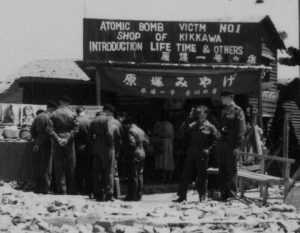Documenting Hiroshima 80 years after A-bombing: On August 10, 1952, Atomic Bomb Survivors Association formed
Feb. 25, 2025
yle="font-size:106%;font-weight:bold;">Survivors share with each other stories of suffering
by Michio Shimotaka, Staff Writer, and Kyosuke Mizukawa, Senior Staff Writer
On August 10, 1952, an inaugural ceremony marking the founding of the Atomic Bomb Survivors Association was held in Chion Hall (in Hiroshima City’s present-day Naka Ward), with dozens of A-bomb survivors in attendance. At the gathering, group members decided on the association articles, and five members were appointed to serve as association executives, including Kiyoshi Kikkawa, whose entire back was covered in keloids from burns caused by the atomic bombing and who was known as “Atomic Bomb Victim No. 1,” and Sankichi Toge, a poet who had also experienced the atomic bombing.
Forerunner of A-bomb survivor movement
The association’s articles read, “United as victims and with the support provided by so many others, the association aims to resolve issues involving medical treatment, daily life, as well as other challenges facing the survivors and work for peace to ensure such a tragedy is never repeated.” In that way, the group served as the forerunner in Hiroshima of the A-bomb survivors movement, demanding aid for survivors and opposition to nuclear weapons.
The move to found the association began in June. In 1951, Mr. Kikkawa, who had formed the Rehabilitation Group for A-bomb Survivors, met with Mr. Toge and Takeshi Kawate, a student at Hiroshima University who was engaged in editing a poetry collection together with the Hiroshima poet, and discussed establishment of a new A-bomb survivors’ organization. The idea was based on what they saw as a need to more vehemently and proactively demand relief for the survivors and call for peace.
In April 1952, the occupation of Japan ended. In June that year, the filming of the movie Genbaku no Ko (in English, ‘Children of the A-bomb’) began in Hiroshima City. About that period, Mr. Kikkawa would later write in his book titled Genbaku Ichigo to Iwarete (in English, “I was called ‘Atomic Bomb Victim No. 1’”), published in 1981, “I began to feel a kind of new enthusiasm.” In July, when Mr. Kikkawa invited Kaneto Shindo, the film’s director, and others to participate in a roundtable discussion, further momentum for establishment of the new group grew among the participants at the gathering, which led to the group’s initiation of member recruitment.
On August 6, 1952, when the Peace Memorial Ceremony was held at the Peace Memorial Park development site (in Hiroshima’s present-day Naka Ward), association members set up a desk on the street to recruit applications for membership. Mr. Kikkawa placed a signboard at a souvenir shop he managed near the A-bomb Dome that read, “If you are an A-bomb survivor, please contact us.” Shizuko Abe, 25 at the time, who is now 98 and a resident of Hiroshima’s Minami Ward, was one of the survivors who happened to pass by the shop and catch sight of the sign. Ms. Abe said, “I got to know Mr. Kikkawa through the experience and began to engage in the association.”
On August 6, 1945, Ms. Abe had suffered burns to her face and hands in the atomic bombing after leaving her house in the village of Nakano (in Hiroshima’s present-day Aki Ward) to engage in building-demolition work. Her husband, Saburo Abe, compassionately supported her after he returned from the battlefield in December. However, she suffered emotionally from insensitive comments about her condition made by others.
Ms. Abe said, “Some would look askance at our house and speak behind our backs, saying ‘The man of the family is still married to a woman with those injuries.’” Because of the wounds to her face, children in the neighborhood used to call Ms. Abe a “red ogre.” She had no opportunities to reveal or discuss with others in the neighborhood about her A-bombing experiences.
She therefore looked forward to receiving postcard invitations from the association announcing meetings. “I felt consoled when I attended the association’s meetings where A-bomb survivors would gather. I had a chance to listen to the sad, painful feelings they kept inside, and they would listen to my own stories of suffering.”
Following year, member number increases to 300 people
The association established its office in Mr. Kikkawa’s shop. In April 1953, the number of members increased to around 300 people. Many of the inquiries from survivors involved the treatment of injuries from the atomic bombing and so-called “A-bomb disease.” In October 1952, the association requested the Atomic Bomb Casualty Commission (ABCC; present-day Radiation Effects Research Foundation), an organization founded on the basis of an executive order signed by the president of the United States, the country that had dropped the atomic bombs, to be formed as a medical institution providing free medical treatment to the survivors. However, ABCC dismissed the request, arguing that such work did not fall within the organization’s mission. With that, the association decided to adopt a policy of non-cooperation with ABCC’s studies.
Lobbying for free treatment for the survivors from the national budget and demanding the city and prefectural governments adopt special measures for the impoverished. Those were projects carried out by the association, and they included the “collection of personal accounts from the survivors.” Ms. Abe would be asked to write about her own experiences.
(Originally published on February 25, 2025)









